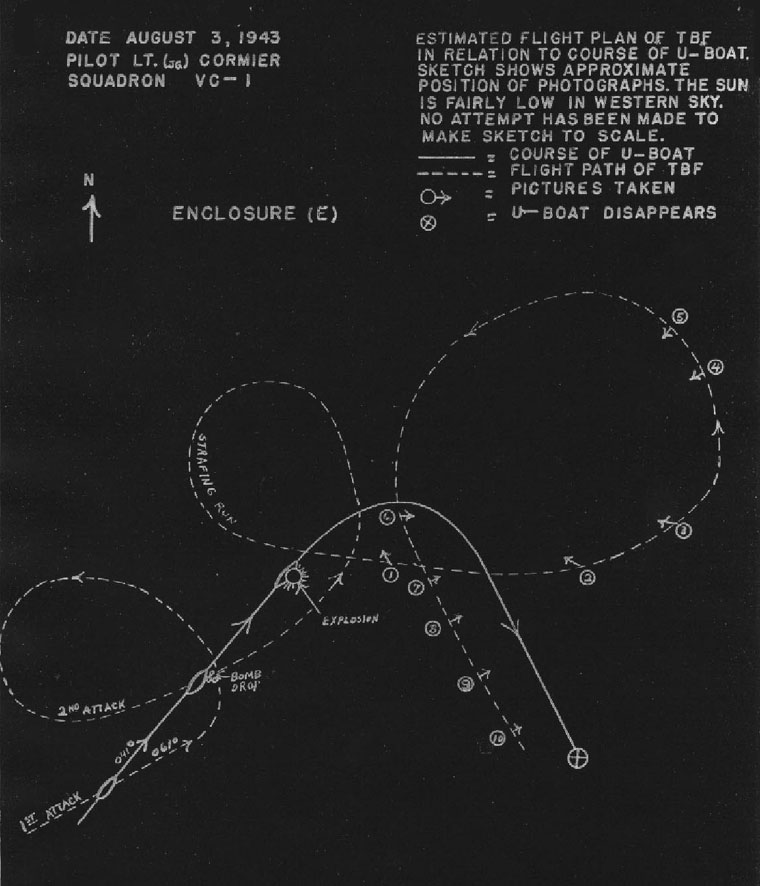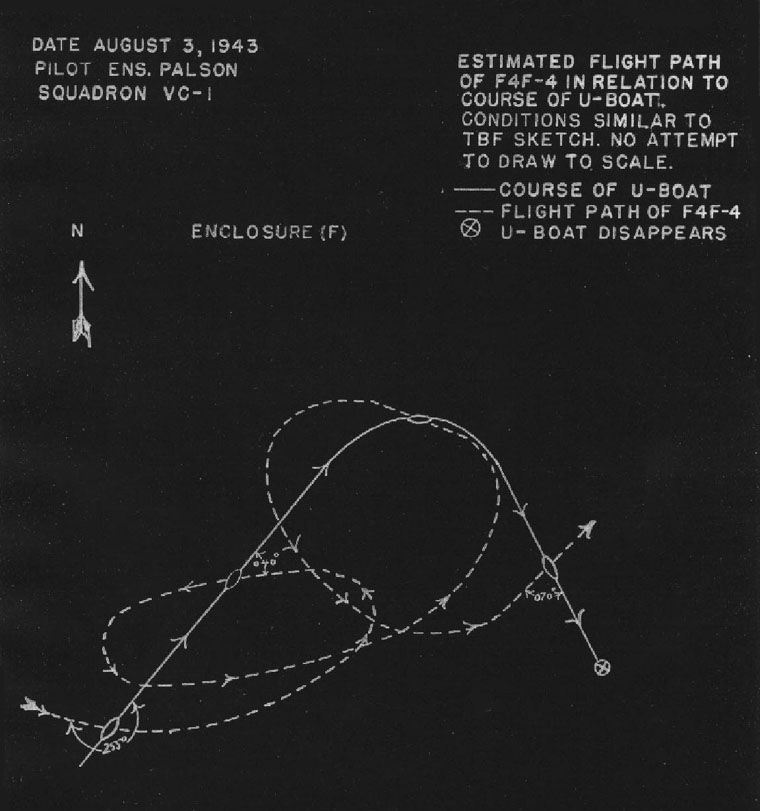COMPOSITE SQUADRON ONE |
||||||||||||
| File No. VC-1/A8 | ||||||||||||
| Serial No. (20) | ||||||||||||
c/o Fleet Post Office, |
||||||||||||
New York, New York. |
||||||||||||
23 August 1943. |
||||||||||||
SECRET |
||||||||||||
From: |
Commander, Composite Squadron One. | |||||||||||
| To: | Commander in Chief, U.S. Fleet. | |||||||||||
| Via: | (1) Commanding Officer, U.S.S. CARD. | |||||||||||
| (2) Commander in Chief, U.S. Atlantic Fleet. | ||||||||||||
| Subject: | ASW-6 Report No. 1-43. | |||||||||||
| Enclosure: | (A) ASW-6 Report No. 1-43. | |||||||||||
1. Enclosure (A) is forwarded herewith. |
||||||||||||
| C. E. JONES. | ||||||||||||
| - - - - - - - - - - - - - - - - - - - - - - - - - - - - - - - - - - - - - - - - - - - - - - - - - - - - - - - - - - - - | ||||||||||||
| CVE-11/A16-3 U.S.S. CARD 23 August 1943. | ||||||||||||
| 1st Endorsement | ||||||||||||
| SECRET-SECURUTY | ||||||||||||
| From: | Commanding Officer. | |||||||||||
| To: | Commander in Chief, U. S. Fleet. | |||||||||||
| Via: | Commander in Chief, U. S. Atlantic Fleet. | |||||||||||
| 1. Forwarded | ||||||||||||
| 2. Fully satisfactory photographs were not obtained for the following reasons: | ||||||||||||
|
||||||||||||
| (over) | ||||||||||||
SECRET-SECURITY |
||||||||||||||||||||
| - - - - - - - - - - - - - - - - - - - - - - - - - - - - - - - - - - - - - - - - - - - - - - - - - - - - - - - - - - - - | ||||||||||||||||||||
| 3. The remarks of the Squadron Commander on the material failures are concurred in. An attempt was made to foresee possible malfunctioning of the bomb arming and release mechanism when the planes were airborne by requiring such controls to be specially tightened. In view of the subject failure, however, it is now required that these controls be particularly taut. Plane #2 has subsequently been tested with water filled bombs while airborne, and both arming and release mechanisms functioned satisfactorily. | ||||||||||||||||||||
| 4. A separate and independent emergency mine release has now been installed in all planes. Each plane has further been equipped to provide electric as well as manual arming for the mine starting yoke, with the further addition of a long special arming wire which the radioman grasps in his hand. | ||||||||||||||||||||
| 5. Preliminary analysis of this attack, as well as its execution, was made difficult by the material failures, and by the lack of comprehensive photographic evidence. It is considered however, that the following rational hypothesis satisfactorily explains all happenings: | ||||||||||||||||||||
|
||||||||||||||||||||
- 2 - |
||||||||||||||||||||
23 August 1943. |
||||||||
SECRET-SECURITY |
||||||||
| CVE-11/A16-3 | ||||||||
| (0011) | ||||||||
| Subject:: ASW-6 Report, forwarding of. | ||||||||
| - - - - - - - - - - - - - - - - - - - - - - - - - - - - - - - - - - - - - - - - - - - - - - - - - - - - - - - - - - - - | ||||||||
|
||||||||
| 6. In view of the above, and considering that: | ||||||||
|
||||||||
| it is evident that the only logical explanation is that the mine functioned normally after arming its starting yoke, striking the submarine either at minimum depth or while hunting for minimum depth. | ||||||||
| 7. As the result of the above mine explosion in direct contact with the hull, and in view of the suddenly steepened angle of the submarine during its final dive, it is considered that this submarine was definitely sunk. | ||||||||
| A. J. ISBELL. | ||||||||
| Advance Copy Direct to: | ||||||||
| COMINCH | ||||||||
| CONAIRLANT | ||||||||
| COMAIRASDEVLANT | ||||||||
- 3 - |
||||||||
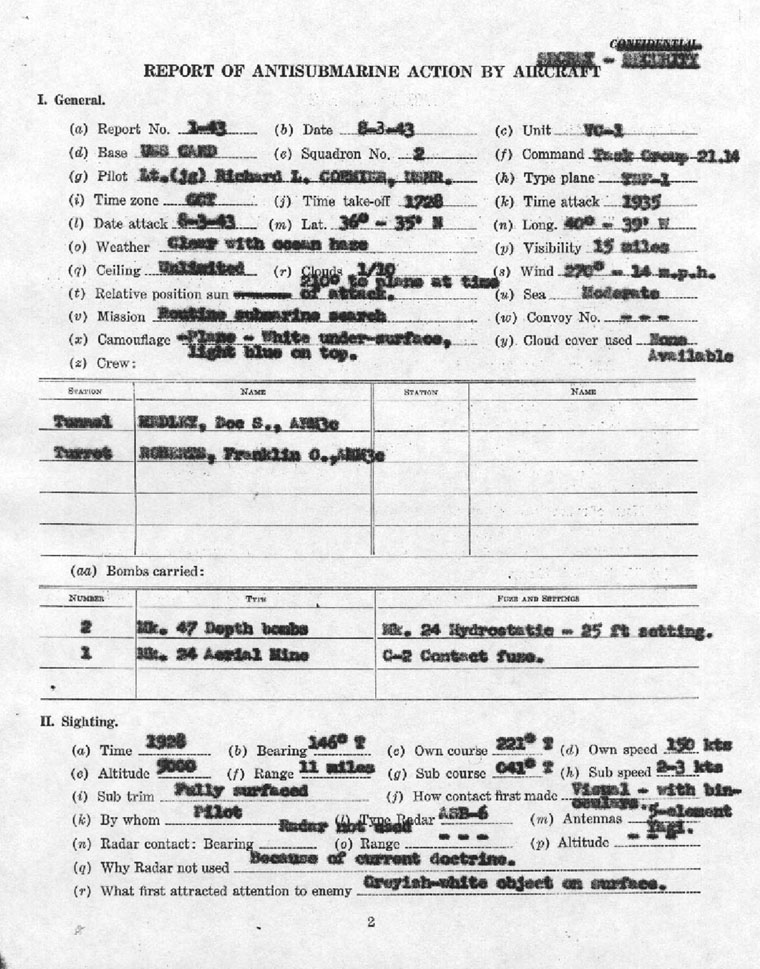
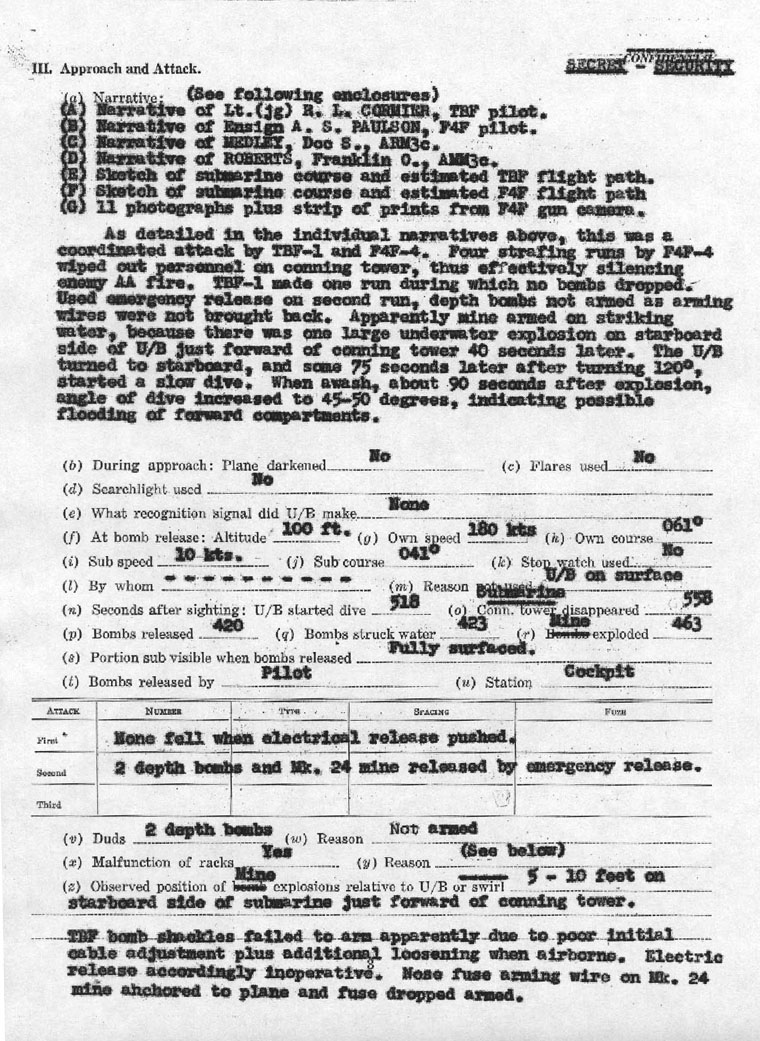
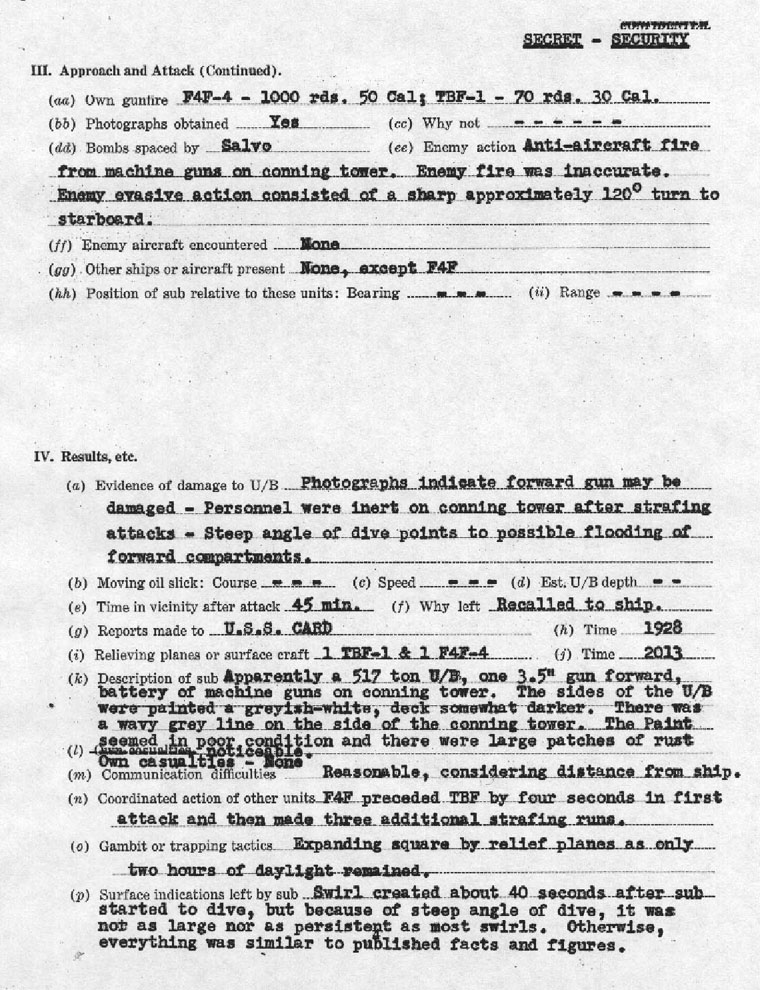
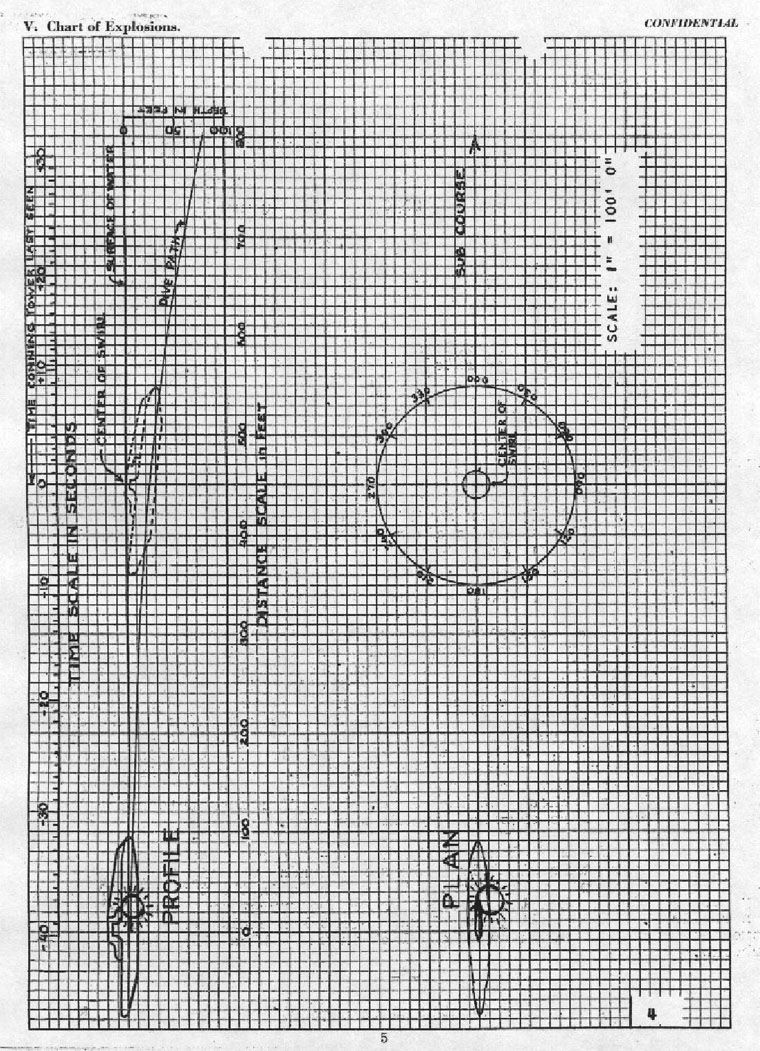
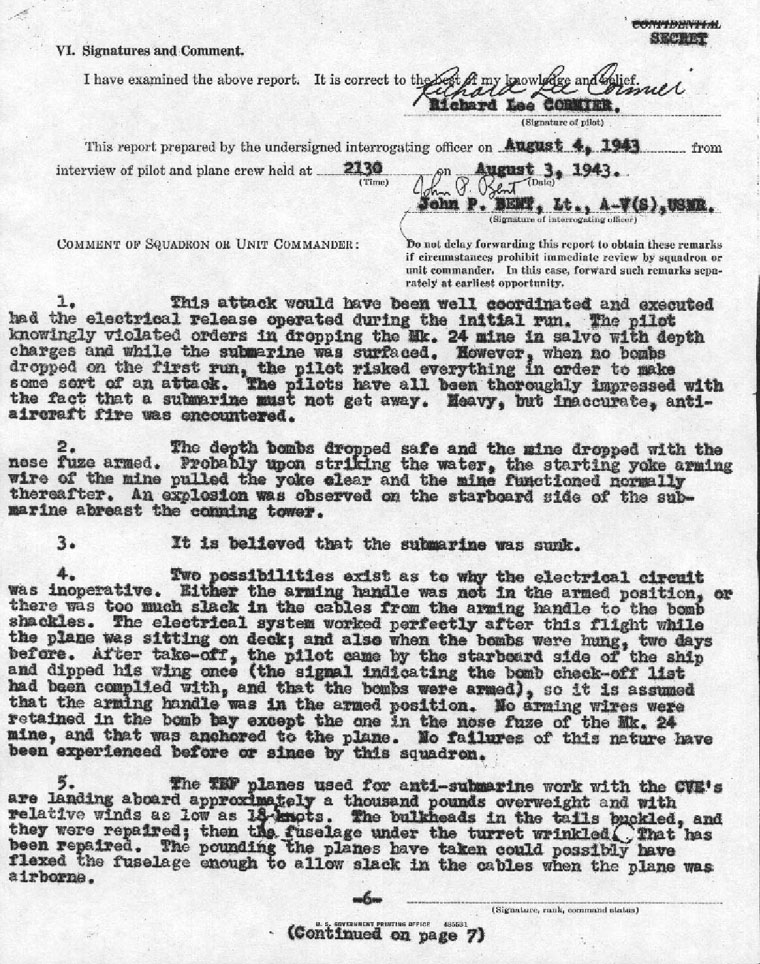
COMPOSITE SQUADRON ONE |
||
| SECRET-SECURITY | ||
| COMMENT OF SQUADROON OR UNIT COMMANDER: (CONT'D) | ||
| 6. The turret gun did not operate because the sear slide was installed in reverse. | ||
| 7. The TBF planes of this squadron have had the bomb bays modified to carry one Mk. 24 mine and two Mk. 47 depth bombs. This was a squadron modification and installation. However, it has been very successful, even in crash landings. It is recommended that a standard fold-away installation, torpedo type, be issued to squadrons concerned. | ||
| 8. A separate and independent emergency mine release has now been installed in all planes. | ||
| 9. Ensign PAULSON, pilot of the F4F-4, was on his second flight off a carrier. It was gratifying to see the photographs taken with his camera gun. | ||
| C. E. JONES, | ||
| Lieut-Comdr., A-V(N), USNR, | ||
| Commander VC Squadron One. | ||
- 7 - |
||
COMPOSITE SQUADRON ONE |
|||
| SECRET-SECURITY | August 4, 1943. |
||
NARRATIVE OF LIEUTENANT (JG) R. L. CORMIER, A-V(N), USNR |
|||
| I was flying at 5000 feet, course 2210 T, with Ensign A. S. PAULSON in F4F-4 airplane No. 13 on my starboard quarter slightly above. The weather was clear with slight haze, about fifteen mile visibility, with a few small cumulus clouds at 2500 feet. Radar was not being used. With my binoculars, I sighted a greyish-white submarine 11 miles away, 750 on my port bow, fully surfaced, cruising slowly (2-3 knots), on a course of 0410 T. There was no noticeable wake or bow wave. I reported contact at 1928 (GCT) as bearing 2150, 75 miles from U.S.S. CARD. | |||
| There being no cloud cover, I turned immediately, notified my crew to make all preparations for attack, and told the fighter to make a strafing run. I then opened my bomb bay doors and went over my arming check-off list with my radioman three times before reaching the point of attack. The fighter went in ahead, and 4 seconds later I made my first run, target angle 1900. Despite the previous checks, the depth bombs failed to release. Apparently the submarine was caught flat-footed, because there was no AA fire during this run, but immediately thereafter, the sub's speed started increasing, eventually reaching 9-10 knots. | |||
| I didn't strafe on this run, for I was concentrating on the bombing attack and was depending on my turret gunner with his .50. Unfortunately, the turret gun would not fire on this run, or either of the later two. | |||
| The fighter made another strafing run while I circled to attack again. There was no evidence of an attempt to dive, and by now, the conning tower machine guns had been manned. This time I came in from a little more to port, target angle of 1950 or 2000, again pressed my electrical release, and then immediately pulled my emergency release to be sure something would drop. I strafed with my .30 going in, but can't tell with what results. The sub had opened up with his AA fire against the fighter as he made his second attack, and then swung around toward us. I saw tracers on both sides, and they seemed to be spraying rather than concentrating their fire. | |||
| The Mk. 24 Mine and both depth bombs left the plane when the emergency release was pulled. About forty seconds later, after making a climbing turn to port that ended about 2000 yards from the submarine, I saw a shock wave that was centered about 10 feet to starboard of the sub and just forward of the conning tower. | |||
| ENCLOSURE (A) - 1 - | |||
COMPOSITE SQUADRON ONE |
||
| SECRET-SECURITY | ||
August 4, 1943. |
||
| NARRATIVE OF LIEUTENANT (JG) R. L. CORMIER, A-V(N) USNR CONT'D | ||
| This wave swept out not only to starboard but also over on the port side of the submarine. The U-boat seemed to be lifted from below and then listed to starboard. Then a heavy column of water about 125 feet high obscured the submarine from view. Immediately afterwards, it entered a tight turn to starboard, altering course 1200 or more. It straightened its course on about 1600 T and started a slow dive which was about half completed when the submarine nosed over on an angle of 45-50 degrees and disappeared from sight. This was about 90 seconds after the explosion. | ||
| Following the explosion, the fighter made a third strafing attack which I followed, using my fixed 30 caliber gun. Submarine AA fire ceased after the explosion. I saw five or six people on and around the conning tower up to the time of the last strafing attack, but I didn't see any fall or wash overboard. I dropped a marker and remained over the spot for 45 minutes before being recalled to the ship. | ||
| During that time and during subsequent search by other planes, no debris, oil, or air bubbles were observed. | ||
| There was no insignia, number, or other marking on the submarine except the grey band on the conning tower. | ||
| The machine gun fire appeared to be the equivalent of 50 caliber or larger, judging from the tracers. | ||
| R. L. CORMIER. | ||
| ENCLOSURE (A) - 2 - | ||
COMPOSITE SQUADRON ONE |
||
| SECRET-SECURITY | ||
August 4, 1943. |
||
NARRATIVE OF ENSIGN A. S. PAULSON, A-V(N) U.S.N.R. |
||
| In F4F-4 airplane, No. 13, I was flying wing on Lieutenant (jg) R. L. CORMIER during a routine submarine search. I noticed the TBF signal and turn to port. Almost immediately, I saw the U-boat, greyish-white in color, distance about 10 miles, and followed instructions to make strafing run prior to bombing attack. At full throttle I headed directly for the U-boat, coming in at about 100 foot altitude, target angle 2550. About 500 yards out, I opened fire, my point of aim being aft at the base of the conning tower. During this run, no personnel were noticed and there was no return AA fire. Bullets were observed striking the water line, coming up over the deck and then covering the conning tower. There were large rusty patches all over the conning tower, apparently dry, as the impact of the bullets sent up a noticeable cloud of dust. | ||
| As I circled sharply to the left to make another run after the TBF attack, I saw a dark smoke coming out of the stern. this probably was engine exhaust as the U-boat's speed was increased. At the time of the first attack it was barely underway, and it seemed that complete surprise was affected. | ||
| Seeing no bombs fall from the TBF, a second strafing attack was made, target angle 0400. Inaccurate AA fire met this attack, and for the first time, 6 or 8 people were seen on the conning tower. They were raggedly dressed and wore no life jackets. It is probable that some were hit on this attack, and the AA fire shifter to the new target. I observed the bombs drop and about 35 seconds later, while in my third run, an explosion occurred. It seemed to be at least 100 feet high and very close aboard the starboard side of the submarine near the conning tower. | ||
| The U-boat started turning to starboard after the explosion. During my next run, there appeared to be some inert personnel on the conning tower. After turning 1300 to starboard, the U-boat started to dive slowly. This was about a minute and a half after the explosion. When the dive was partially completed, the U-boat suddenly nosed down and seemed to pivot about an axis 15 feet forward of the stern hydroplanes, and go under the water at an angle of 500. I was just before this final dive that I made my fourth strafing run, target angle about 0700 and the point of aim was the underside of the stern. | ||
| ENCLOSURE (B) - 1 - | ||
COMPOSITE SQUADRON ONE |
||
| SECRET-SECURITY | ||
August 4, 1943. |
||
NARRATIVE OF ENSIGN A. S. PAULSON, A-V(N) U.S.N.R. CONTINUED |
||
| I dropped a sea marker, gained altitude and after checking with Lieutenant (jg) CORMIER, headed back to the ship. My ammunition was almost expended. I had no wing tank, and had reached my PLE. | ||
| A. S. PAULSON. | ||
| ENCLOSURE (B) - 2 - | ||
COMPOSITE SQUADRON ONE |
||
| SECRET-SECURITY | ||
August 4, 1943. |
||
NARRATIVE OF MEDLEY, Doc Stough, 604 16 61, ARM3c, USNR |
||
| The pilot sighted sub 12 miles from plane and ordered us to make ready for an attack. Via interphone we went over the bomb check-off list three times. I then took the camera and stationed myself where the .30 caliber stinger was formerly mounted. Took two pictures that didn't come out, then I returned to my seat to take other pictures when pilot asked if bombs had dropped. I reported that they had not fallen and was told to make ready for second attack, that emergency release would be pulled. | ||
| I saw bombs leave the bomb bay. About 40 seconds later, there was a big explosion of water within 5 to 10 feet of the conning tower on the starboard side. The sub rocked to starboard, changed course and after a minute or so, nosed over with stern out of water and disappeared. We dropped a sea marker, circled, but saw nothing else. | ||
| Doc Stough MEDLEY. | ||
| ENCLOSURE (C) | ||
COMPOSITE SQUADRON ONE |
||
| SECRET-SECURITY | ||
August 4, 1943. |
||
NARRATIVE OF ROBERTS, Franklin O., 551 92 13, AMM3c, USNR |
||
| The sub was sighted by Lieutenant (jg) CORMIER about 12 miles away. We were told to get ready for attack. The fighter was told to strafe. I was in the center cockpit at time of sighting but was able to return to turret ready for attack by the time fighter passed us. Before I could realize it, we had finished our first run, but nothing happened. While pulling out, I brought the turret gun to bear, but the gun would not fire, no matter how often I charged it. Unfortunately, I could not locate the trouble. | ||
| By now the fighter was finishing his second run, doing a very thorough job. Also the sub had increased its speed and 5-8 men were observed on and around the conning tower. The sub opened fire on the fighter and then on us. | ||
| We started our second run and as we pulled away after about 40 seconds, I saw amidships, a column of water about 125 feet high very close to the starboard side of the sub. The sub quivered, raised about three feet, and settled on the starboard side. It returned to level keel and a short time later made a very sharp turn to starboard. It looked as though she began to settle slowly and then she went into a very steep dive at which time her stern rose out of the water. | ||
| After dropping a sea marker, we remained over the spot for about 45 minutes before returning to the ship. | ||
| Franklin O. ROBERTS. | ||
| ENCLOSURE (D) | ||
